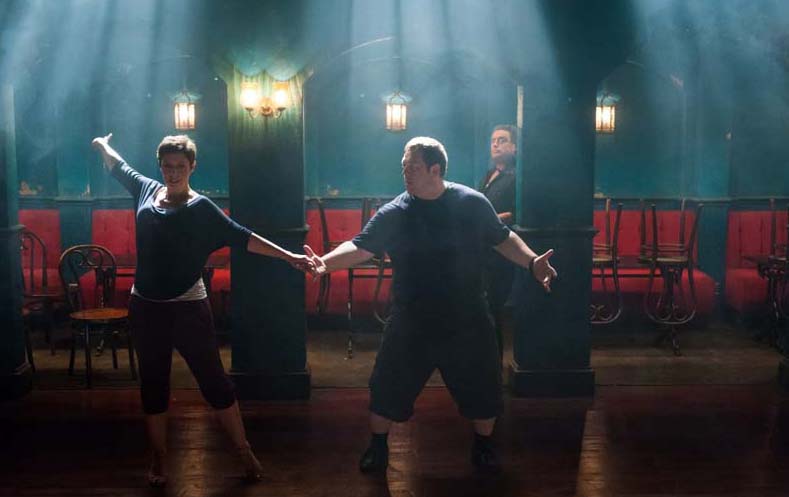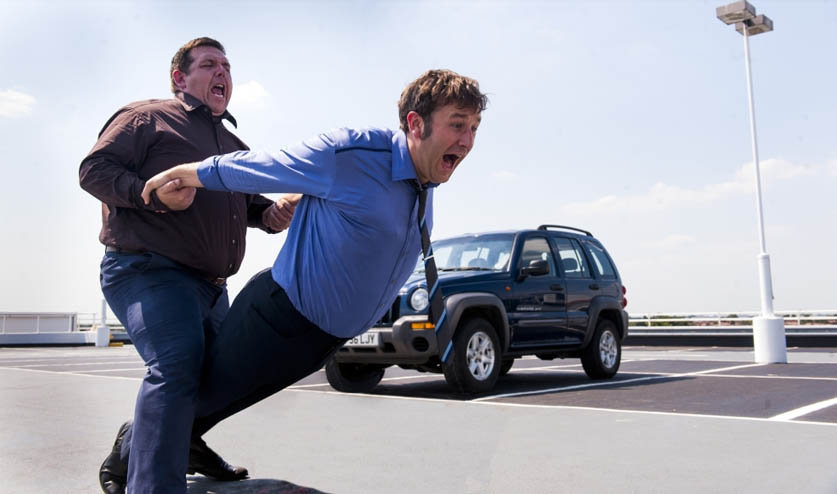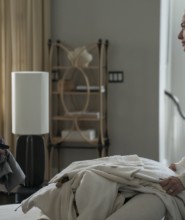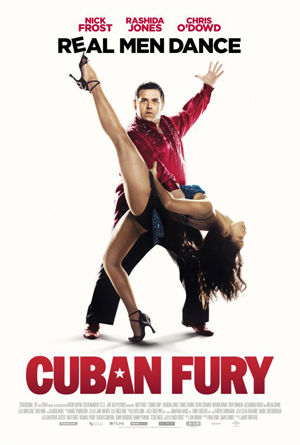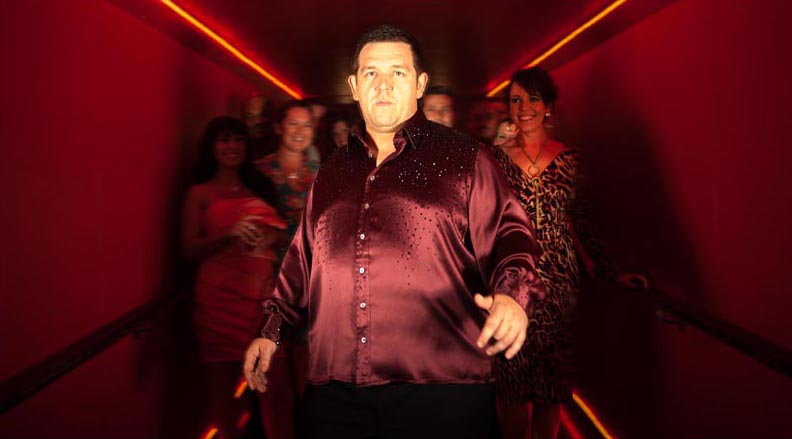
“Cuban Fury” – Interview with Nick Frost
by Sara Michelle Fetters - April 11th, 2014 - Interviews
No Turning Back: Nick Frost Dances His Way to Redemption in Cuban Fury
Sprung forth from an idea that had been lingering on the forefront of actor Nick Frost’s brain for some time, Cuban Fury is a Salsa-fueled romantic comedy that’s one part Strictly Ballroom, another part Rocky and final part Four Weddings and a Funeral. It’s a delightful little bit of dance-filled euphoria that’s almost impossible to dislike, everything building to beautifully rousing climax that makes up in laughter and heart what it lacks in originality.
The plot revolves around Bruce Garrett (Frost), a former Salsa wunderkind who allowed bullies to spoil his dream of dancing stardom leading him down a path into corporate drudgery and melancholic regret. But when his new American boss, Julia (Rashida Jones), shows a love for Salsa almost equal to his own Bruce decides to return to his roots and see if he can find the Cuban-flavored groove once again, reigniting a passion for living life he thought was gone forever.
I sat down with the actor to talk about this passion project of his and what it took to bring it all to fruition. Here are some of the highlights from that conversation.
Sara Michelle Fetters: Do I have this straight? The idea for this film started out as a drunken email?
Nick Frost: That was the catalyst. That was the point from which there was no turning back. [laughing]
No, in all honesty, [Cuban Fury] started out as a few kind of different things. The first was that I’ve always liked dancing. Additionally, I’ve always been kind of good at it even though I’m oftentimes crushed by the expectation that I should dance. When it is expected of me I probably then don’t want to do it. As a result of that I kind of messed up my wedding. I didn’t want to do a first dance and when we ended up doing one it was kind of terrible. I’ve never been able to live that down.
The flipside of that is that I’ve always wanted to secretly do a dance film and play a dancer. I think, after doing Hot Fuzz, Shaun of the Dead and The World’s End I think I decided it was important for me to do something uncomfortably comfortably different, and dancing was it.
Now, the drunkenness comes in when it comes to the fact I had this idea but I wasn’t sure I should share it with anyone. Every now and then it was push its way into my mind and say that I needed to tell someone about the idea and I’d kind of wrestle with it and end up not actually telling anyone. One day, though, I came home from a party a little worse for wear and wrote a very long email to my producer Nira [Park] basically pitching the entire film to her in massive detail. In the end I kind of did that thing where your finger pauses above the send button before pressing, subsequently falling asleep with my clothes on waking up the next morning feeling really guilty but not recalling why. Next thing I knew there was an email in my inbox from Nira saying how great the idea was and that she wanted to have a meeting. And that was it. I’d been caught. I’d probably wanted to be caught. But, either way, from that point on there was no turning back.
Sara Michelle Fetters: How fast did things move from that point?
Nick Frost: Let me tell you, from that email, to the first day of production, it was like 15 months, which is nothing. We found a screenwriter. We found a director. We got funding and we assembled a cast. Within no time we were shooting. It was time to dance.
Sara Michelle Fetters: What led you to your screenwriter Jon Brown? What made him the right man for the job?
Nick Frost: We’d known Jon for some time, [Nira] and I had been a fan of his and we just thought he was potentially a good fit for the project. He and I met and I presented the idea and he responded to it right away. He probably wrote the first draft of the script in something like 12 weeks, which is a little unheard of. With his background coming from television he could have easily turned in a first draft that felt like a three-hour T.V. show but it wasn’t that at all. The script was a beautifully crafted film right there on the page. At the same time, he was more than happy to sit in the room and listen to our ideas and feedback. He’d go off and write and come back with material that was so much better than anything we could have imagined for ourselves.
I think, after writing Paul and other little bits and pieces of other films I’ve worked on, I made the conscious decision that I didn’t want to write the script for this one. But, more than that, I didn’t want to bring somebody like the lovely Jon Brown onboard and then start telling them what to do. I wanted to give ideas and then see what he would come up with. You have to trust him. You have to believe that he will deliver a good script and that it will end up being the thing that allows you to make the film you wanted to right from the start. Jon did that. It was a lovely coupling.
Sara Michelle Fetters: Did your background working on the Cornetto Trilogy, working so closely with Simon Pegg and Edgar Wright on those three films as well as other projects, did this allow you to have that trust in Jon that he could take your idea and make something worthwhile out of it?
Nick Frost: You have to have that trust. You have to be able to step away. The other option would be to be really, really annoying to everyone you’re collaborating with if you were to figuratively hand off work only to get involved and put your foot down at every opportunity. Doing what we do, making Hot Fuzz, Shaun of the Dead, The World’s End and Paul, we’ve been lucky to work with a lot of the same people, not just cast but also crew, so you kind of get a group in your rolodex who are A) the best and, B) trustworthy. This enables you to concentrate on learning how to dance and the performance part of it all knowing that the rest of the filmmaking aspects are being handled by people who know what it is they’re doing and will bring their best efforts to the production.
Sara Michelle Fetters: With that in mind, what was harder, finding the nuances of the character or actually learning how to Salsa?
Nick Frost: Dancing! Definitely, the dancing.
Finding a character, that’s what my job is, and if I couldn’t do that than I’m working in the wrong profession. Making lines on a page funny out loud, that’s what I’m supposed to do, and I’ve kind of spent the last dozen years or so learning how to do just that. This wasn’t a big issue to me. I had a great script to work with and I trusted I’d be able to do my job and find Bruce, for me that was never really an issue.
The issue was dancing. About an hour into the first day of seven months of training I could see myself in this big mirror kind of dry humping the s**t out of my instructor and I knew right then I’d made this terrible, horrible mistake. But, you know, you can’t go back, you can’t change your mind. As much as I grew to love it [dancing] I can’t say it got any easier because the better you got the more stuff they wanted to throw at you. I mean, I didn’t learn any choreography until right up until two weeks before we started shooting. It was all about doing that Army Strong, U.S. Marine boot camp thing where they shatter you into a million pieces and then build you back up to the point where you’re this fiery Salsa champion.
But it was frustrating at first. Frustrating in that you want to know the choreography so you can be prepared, so you have it to rely on. But it was only when we got on the set and we started to film the dance scenes that I realized what they had given me was essentially the power and the skill to pick up choreography and adapt really easily. It was only then I realized what the master plan had been all along.
Sara Michelle Fetters: I love the organic evolution of the character. There’s a point early on that I feel like you can see the disconnect between Bruce’s muscle memory and his mental memory, that as a former Salsa champion he knows what moves he wants to do but 25 years removed from doing them his body can no longer instantaneously respond.
Nick Frost: The first time you see Bruce dance in the film, when he kind of gets his ass handed to him by the wonderful Yanet Fuentes, we shot that scene three or four times when the director [James Griffiths] came over to me and proclaimed I looked too good in the sequence, which was kind of the oddest problem we could possibly have ever had. I think my response, half-jokingly, was to ask why we hadn’t shot the scene before I spent seven months leaning how to Salsa.
But, honestly, I think that knowledge helped because I was forced to unlearn what I’d spent so much time learning, and with that I think you can see in the performance that Bruce knows what he wants to do but his body has become so out of shape and lethargic it can’t respond. There’s still some muscle and mental memory there but they can’t connect together like they did when he was a teenager. This makes Bruce frustrated and angry, and while he’s initially embarrassed I also think this fact, this knowledge that he does still in fact know what he wants to do but it’s just his body that’s out of practice, is what ultimately gets him back on the dance floor not caring if he looks like a fool or not.
Sara Michelle Fetters: Talk to me about Rashida Jones and Chris O’Dowd, how did they get involved with the project?
Nick Frost: Rashida and I had bumped into one another a bunch of times over the years and we’d always known we wanted to work at some point together but never really thought it would happen. But somehow we managed to get her to come out to London and she and I had a lunch which suddenly turned into drinks over dinner which transformed into cocktails at eight o’clock and it was like no time at all had passed. It was like we had been friends forever. It clicked. I’m a big believer that those kind of relationships, acting relationships or people you allow to be a part of your life, it’s still a rare thing for people to just immediately get one another like that.
With Chris O’Dowd, I’d worked with him on [Pirate Radio] and we’ve been friends for about eight years now and I do think he’s one of the few individuals I know that sometimes I just can’t look at him. He makes me laugh so much. He destroys me, and he doesn’t even have to do anything. You know what I mean? There’s just something about him, his persona, he’s just so inherently funny and it’s almost like he doesn’t even have to try. It annoys me that he makes me laugh that much. We cast him anyway.
Sara Michelle Fetters: The dance battle that you two have, how difficult was that sequence to shoot? Not just physically, but I imagine just from an acting standpoint as well. How did you two keep from constantly cracking one another up so you could finish the scene?
Nick Frost: Anytime we shot dancing in this film, whether it be the dance final or the dance battle between me and Chris, the dancing was hectic. It was tough. I mean, obviously it was fun, but it was also work. A lot of it. Whenever the cameras weren’t rolling I was doing the [choreography] again and again and again so I could make sure we would get it right. That it would look perfect.
So, the dance sequences were a pain in the ass. With Chris and I during the battle there just wasn’t a lot of room silliness because we were so focused on getting everything in regards to the dancing right. When it was just Chris in me in the office, or Chris and me and Rashida in a car, we’d laugh for hours doing that stuff, flubbing our lines continually. But when it was time to dance we were focused, intent on getting it right so there wasn’t a lot of time for additional antics.
This fight, it was shot on top of and inside a multi-storied car park on the five hottest days of the year. It was 37-degrees Celsius or something like that. We had these weird suits of ice we’d put on to cool down. There was all of this wire work we had to do. It was just this heavily choreographed piece. There was so much to do and to cover, and it’s such a vital moment in the movie it was important that we get it right. The line in the script was something like, “They have a dance-off,” which sounded loony and fun until you realize you’re going to be there for five straight days working like a dog with three choreographers and stunt professionals everywhere and medics making sure you stay hydrated; it was excruciating.
Sara Michelle Fetters: Getting back to the cast for a moment, who had the bright idea to contact Ian McShane for Salsa maestro Ron Parfitt? I can’t say I’d ever have imagined him in a role like this. After watching the movie, I now can’t imagine any other actor being capable of filling his Salsa shoes.
Nick Frost: The ‘Mister Miyagi’ of Salsa? He’s just fantastic, right? I don’t think we could have found anyone better to play the role.
I’d worked with Ian on Snow White and the Huntsman, and I’d come back to the office and I’d be talking with Nira about hanging out with him and all of the stories he’d been telling me. One day while we were going over the list of characters and talking about the actors we’d potentially love to see fill the roles, Nira looked over at me and asked if maybe I shouldn’t ask Ian to play Ron Parfitt. And, I was like, yes, absolutely. Genius. I knew he’d be amazing. I immediately sent him an email asking if he’d like to be in our little Salsa movie and play this great character and be a part of this wonderful ensemble and he sent one back essentially saying, “You had me at Salsa.”
Sara Michelle Fetters: I think what I liked most about the film is that the romance, the dancing, all of that ends up being secondary as far as Bruce’s transformation is concerned. This remains his story, beginning to end, and I liked how empowering it is to see him reawaken to life and all its pleasures he’d for so long allowed himself to grow numb to.
Nick Frost: That was important to us, that interior journey you’re talking about. Most romantic comedies, when you watch them, it ends with a guy and a girl kissing and they look and one another and they look at all their white-teethed friends and that’s it. If she thinks in three weeks he’s not the one than he’s suddenly back where he started. He’s back to being an emotional mess.
What we wanted to do was put Bruce on a journey which essentially puts him back to where he should have been had he not been bullied by those kids at the start of the film. With or without Julia, you should hopefully believe at the end that Bruce is going to be all right now. He’s done all of this for himself. Because of that, he can find love. He can do an even better job at work. He can be a better friend to his sister and to those he cares deepest about. He’s rediscovered a part of himself he’d allowed to become buried under self-doubt and laziness and as such he’s finally a whole person worthy of caring about.
The movie is a romantic comedy, make no mistake, but it is also a movie about a man finding a piece of himself he thought was lost never to be found again. That’s the core story and I think it is the one most in the audience will respond to the most.
Portions of this feature reprinted courtesy of the SGN in Seattle
